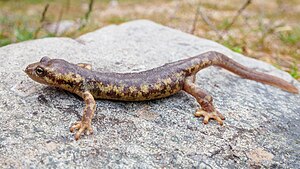Corsican mountain newt
| Corsican mountain newt | ||||||||||||
|---|---|---|---|---|---|---|---|---|---|---|---|---|

Corsican Newt ( Euproctus montanus ) |
||||||||||||
| Systematics | ||||||||||||
|
||||||||||||
| Scientific name | ||||||||||||
| Euproctus montanus | ||||||||||||
| ( Savi , 1838) |
The Corsican Brook Newt ( Euproctus montanus ) is an exclusively on Corsica occurring salamander from the genus of European mountain newts .
features
The species becomes 7 to 9.5, in rare cases up to 11 centimeters long. The head has small but distinct bulges of the ear glands . There is no throat fold. The skin is grainy, but not black and white. The back is either monochrome olive-green to brown or has yellowish spots, which can also merge into a narrow light line along the spine. The ventral side is monochrome light gray to light brown and only rarely has whitish spots. The male differs from the female in that it has a wider head, a thorn-like tip on the rear edge of the lower leg and the conical cloaca in contrast to the rounded cloaca of the females.
Occurrence and habitat
The Corsican mountain newt is endemic to the island . It lives mainly in small mountain streams and in their vicinity at 600 to 1500 meters above sea level. Larger still waters are much less populated because of the predators that are also present there. In a few cases it was found in the lowlands or at altitudes of up to 2200 meters. He prefers cool waters of around 10 to 18 ° C. If it stays on land, it stays close to the water and during the day it hides under tree roots and in rock crevices.
Way of life
The Corsican mountain newt is crepuscular and nocturnal and hunts for aquatic insects and their larvae, small crustaceans and worms. Its predators are grass snakes , brown trout and the Corsican disc beak . The wintering between October and March takes place on land. Even in midsummer he can keep a short rest period. The newts breed from March to July. Mating is initiated by the male and can last up to four hours. In a mating season, a female produces only 20 to 30, in exceptional cases up to 60 eggs. Depending on the temperature of the water, the larvae hatch after three to four weeks. The metamorphosis takes place usually in August and in September held in the higher mountains, the larvae overwinter in the water and complete their development to the adult animal until the following year.
literature
- Michel Delaugerre, Marc Cheylan: Atlas de Repartition des Batraciens et Reptiles de Corse . Parc Naturel Regional de Corse / Ecole Pratique des Hautes Etudes, o. O. 1992, ISBN 2-905468-09-2 .
- Andreas Nöllert, Christel Nöllert: The amphibians of Europe . Franckh-Kosmos, Stuttgart 1992, ISBN 3-440-06340-2
Web links
- Photos of the Corsican newt on www.herp.it
- Euproctus montanus inthe IUCN Red List of Threatened Species 2013.1. Posted by: Claude Miaud, Roberta Lecis, Paul Edgar, Marc Cheylan, Antonio Romano, Roberto Sindaco, 2008. Retrieved November 20, 2013.